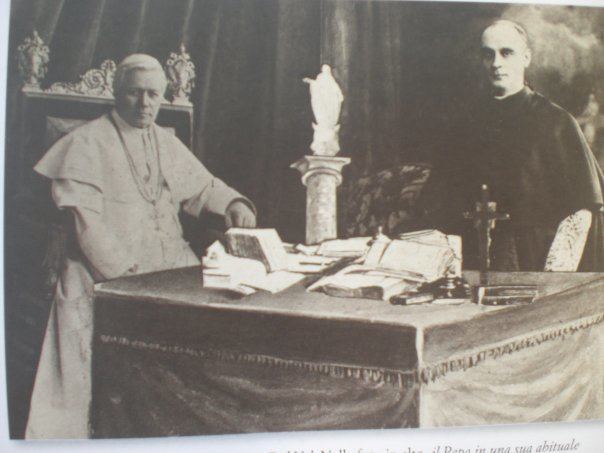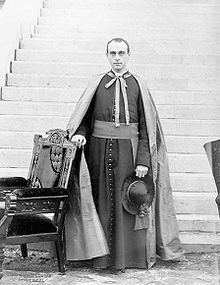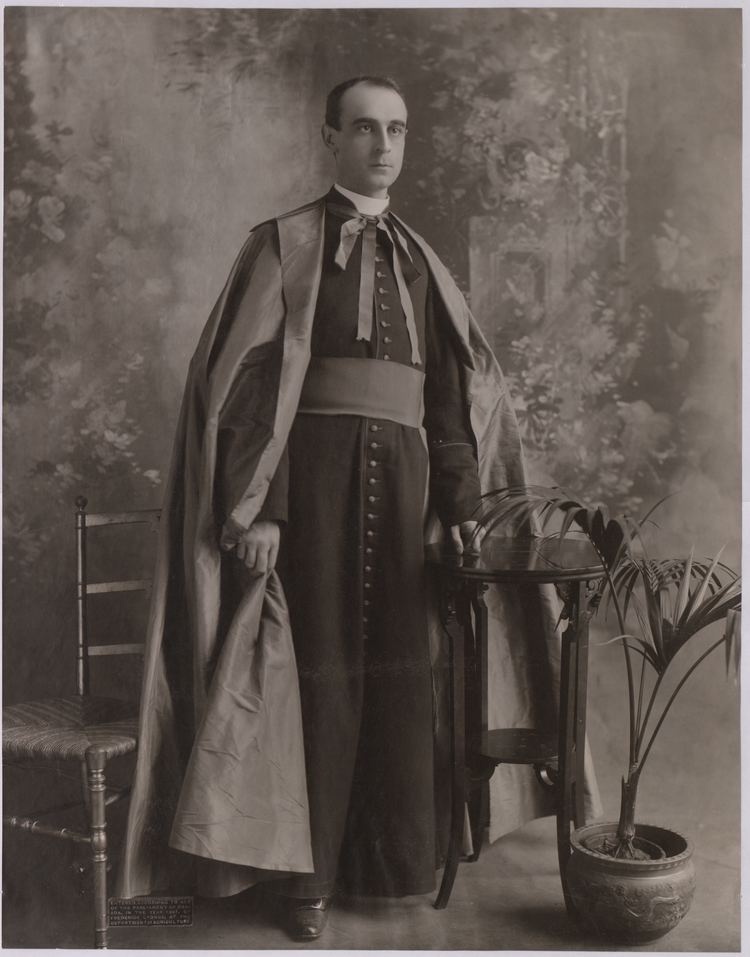Appointed 14 October 1914 Name Rafael del | Ordination 30 December 1888 Term ended 26 February 1930 Consecration May 6, 1900 | |
 | ||
Other posts Cardinal-Priest of Santa Prassede (1903-1930)Archpriest of Saint Peter's Basilica (1914-1930) Books The Truth of Papal Claims: A Reply to The Validity of Papal Claims by F. Nutcombe Oxenham Similar People Pope Innocent XII, Pope Innocent VIII, Otto II - Holy Roman Emperor, Pope Clement XIII, Pope Anastasius III | ||
Rafael Merry del Val y de Zulueta (10 October 1865 – 26 February 1930), was a British-born Spanish Roman Catholic cardinal.
Contents
- Early life
- Education
- Domestic prelate archbishop and cardinal
- Austrian veto at papal conclave
- Cardinal Secretary of State
- Veneration
- Honours
- Works partial list
- References

Before becoming a cardinal, he served as the secretary of the papal conclave of 1903 that elected Saint Pius X, who is said to have accepted his election through Merry del Val's encouragement. Pius X later appointed him as the Cardinal Secretary of State. Merry del Val's writings and example prompted greater popularity for the Litany of Humility, which was for some decades incorrectly attributed to him.

A cause for his canonization was opened in 1953 at the behest of Pope Pius XII. He now has the title Servant of God.

Early life

He was born as Rafael María José Pedro Francisco Borja Domingo Gerardo de la Santíssima Trinidad Merry del Val y Zulueta at the Spanish Embassy in London, England,son of Rafael Carlos Merry del Val as the second of four sons. His mother was Sofia Josefa de Zulueta (died 1925), elder daughter of Pedro José de Zulueta, count of Torre Díaz, of the London bank of Zulueta & Co., and his wife, Sophia Ann Wilcox, who was of Scottish and Dutch ancestry. The Zuluetas were an old Basque family ennobled as counts de Torre Díaz in the nineteenth century. His father was Rafael Carlos Merry del Val (1831–1917), Marquess of Merry del Val, secretary to the Spanish legation in London, a monarchist supporter of Alfonso XII and nobleman. The del Vals were an Aragonese family originally from Zaragoza, claiming descent from a twelfth-century Breton crusader; the surname Merry came from a line of Irish merchants from County Waterford, Ireland, who settled in the late eighteenth century in Seville, Spain. His elder brother Alfonso, marquess of Merry del Val (b. 1864), was Spanish ambassador to the United Kingdom between 1913 and 1931.
Education

Merry del Val lived in England until 1878. His mother's family owned a large villa in Boscombe, a suburb of Bournemouth. He attended a Jesuit preparatory school in Bournemouth at the time the Society was establishing what were to become five parishes and a school. He received his first Holy Communion at Sacred Heart Church on Richmond Hill, and later enrolled at the northern seminary of Ushaw College in County Durham in northern England. He was ordained a priest on 30 December 1888 after receiving a doctorate in philosophy at the Pontifical Gregorian University. He later received a doctorate in theology and then a licentiate in canon law.
Domestic prelate, archbishop and cardinal
In 1891 he became a privy chamberlain and member of the Pontifical family, having served as a secretary in nunciatures. Entrusted by Leo XIII with the question of the validity of Anglican orders, he led the Holy See to the negative response in September 1896 with the bull Apostolicae curae, of which he was the main architect. On the basis of this bull, Leo XIII confirmed the "nullity" of the "ordinations carried out with the Anglican rite", denying the apostolic succession of Bishops of the Church of England.
His continued service in diplomatic posts and in the Roman Curia saw him named Apostolic Delegate to Canada and domestic prelate in 1897 and then president of the Pontifical Academy of Ecclesiastical Nobles (an institution connected to the Roman Curia, in charge of the formation of priests who are to serve in the Diplomatic Corps of the Holy See) in 1899. He was appointed Titular Archbishop of Nicaea on 19 April 1900 and consecrated a bishop by Mariano Rampolla del Tindaro, Cardinal Secretary of State of Pope Leo XIII. In 1902 he was the papal representative to the coronation of King Edward VII, accompanied by Eugenio Pacelli.
He served as secretary of the conclave of 1903 that elected Pope Pius X. By a coincidence, the secretary of the Sacred Consistorial Congregation, who was also the secretary of the College of Cardinals and therefore of the conclave, had died almost at the same time as Leo XIII. In haste, the cardinals chose as his successor Archbishop Merry del Val, who had been ordained a bishop only three years before. The choice had been made from a pool of three names. The two rejected candidates were the substitute for General Affairs of the Secretariat of State, Giacomo Della Chiesa, and Pietro Gasparri, then serving as the secretary for Extraordinary Ecclesiastical Affairs. The preference shown to the youngest and least experienced of the three was interpreted as the first defeat of the Rampolla coalition, and a foreshadowing of what would happen at the conclave.
Austrian veto at papal conclave
According to Rafael Merry del Val, during the conclave of 1903, in which he served in the role of Secretary of the Conclave, Cardinal Jan Puzyna de Kosielsko of Kraków came to see him, demanding to announce his veto against Cardinal Rampolla in the name of Emperor Franz Joseph I of Austria-Hungary. Archbishop Merry Del Val protested and refused even to accept the document, which, in the heat of the debate fell onto the floor and was picked back up by Cardinal Puzyna. Cardinal Puzyna announced the veto anyway, in the presence of the Cardinals gathered in the Sistine Chapel. The College of Cardinals was outraged. Rampolla, according to Merry del Val, actually gained votes after the veto. Later, he opined to Ludwig von Pastor that Cardinal Rampolla never had a chance, because the cardinals wanted a new direction after the pontificate of Pope Leo XIII. After his election, the new Pope Pius X decreed automatic excommunication for anyone trying to influence a conclave with a threat or veto.
Cardinal Secretary of State
After a two-month trial period, Pius X named him pro-Secretary of State. That November he became the first cardinal elevated by the Pope (a traditional reward to the secretary of a conclave), becoming Cardinal-Priest of Santa Prassede and full Secretary of State, replacing Cardinal Rampolla del Tindaro, who was moved to the post of Secretary of the Holy Office.
The praise which he received from Pope Pius X on 11 November 1903, the day Merry del Val received the cardinal's hat, went as follows: "The good odor of Christ, lord cardinal, that you have spread in every place, even in your temporary dwelling, and the many works of charity to which you have dedicated yourself constantly in your priestly ministry, especially in this our city of Rome, have won for you, with admiration, universal esteem."
From Pascendi dominici gregis (published in 1907) until 1914 he was pro-active in combatting modernism among the clergy, especially the university professors. However, he avoided an official canonical acknowledgement of Sodalitium Pianum (in France known as "La Sapinière") and kept a certain distance to the extensive activities of Umberto Benigni; supported by voices from Germany protesting against an "integralist conspiracy". In 1911, Sodalitium Pianum departed of its own volition from the structure of the Secretariat of State.
Among his diplomatic achievements was the signing of a Concordat with Serbia barely four days before the assassination of the Austrian Heir-Apparent, Franz Ferdinand, in Sarajevo on 28 June 1914 plunged Europe into the First World War. Merry del Val recorded that the "breakthrough" in the difficult negotiations with Belgrade came on the Feast of the Sacred Heart. The Pope and his Cardinal Secretary of State were fully aware that war was imminent. Pius X had already warned a departing Brazilian Ambassador a year earlier that Europe would not "get through 1914" without a major conflagration. Merry del Val remained Secretary of State throughout the pontificate of Pius X, but when Pope Benedict XV, an old associate of Rampolla, was elected in the conclave of 1914, Merry del Val was not reappointed. Benedict XV in fact appointed as his Cardinal Secretary of State, first Domenico Ferrata, who died almost immediately, and then Pietro Gasparri. Thus at the head of the Church were the two bishops – Della Chiesa (now Pope Benedict XV) and Gasparri – who had been leapfrogged by Merry del Val on the eve of the conclave in 1903. However, Benedict XV appointed Merry del Val as secretary of the Supreme Sacred Congregation of the Holy Office on 14 October 1914.
After being Secretary of State, the Congregation was considered an important though lesser assignment. The Pope did not appoint him as Prefect, because at the time the Popes themselves were Prefects of the Holy Office. The post of Secretary was then the highest-ranking office in the Dicastery. Merry del Val as secretary was responsible for running the daily affairs of the Holy Office, in which capacity he reportedly explained Pope Pius's policy of non possumus to Theodore Herzl and his emerging movement of Zionism, saying that as long as Jews deny Christ's divinity, the Church could not make a declaration in their favor. When the British Catholic diplomat Mark Sykes visited him to speak about the same topic, Merry del Val was more supportive, indicating that the Holy See would look benignly on the project. After the death of Pope Benedict XV (22 January 1922), Cardinal Merry del Val was retained by Pope Pius XI in the role of Secretary of the Holy Office, a post he held until 26 February 1930, when he died in Vatican City, aged 64, during an operation for appendicitis. The funeral took place in St Peter's Basilica on 3 March 1930 amd the Cardinal was buried in the crypt. On 31 July 1931, a new tomb, gift of the Spanish government, was dedicated by Cardinal Eugenio Pacelli, the future Pope Pius XII.
Veneration
The cause of Merry del Val's canonization was introduced on 26 February 1953, under the pontificate of Pope Pius XII. He therefore has the honorific title, Servant of God.
